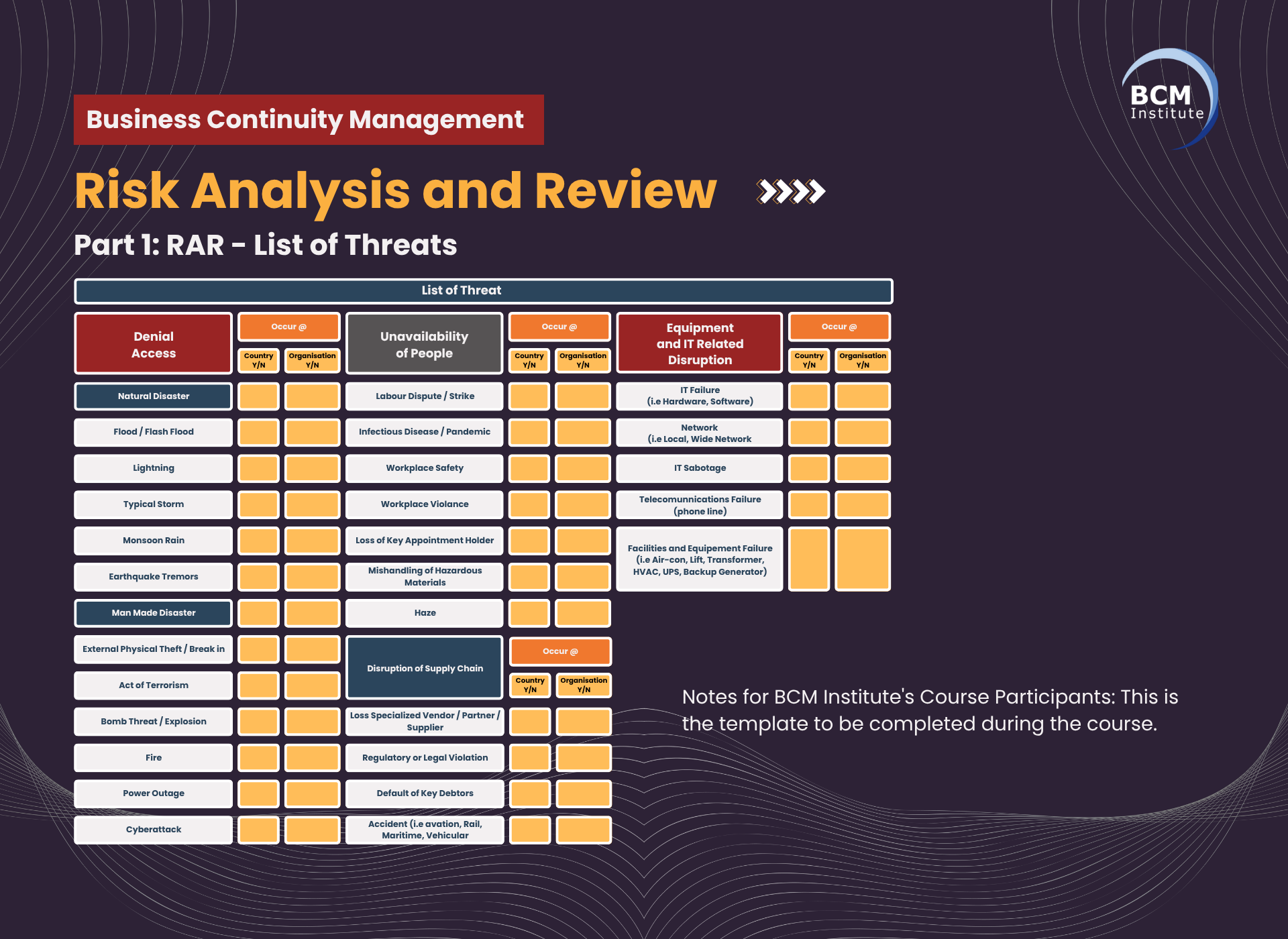[Risk Analysis and Review] [Part 1]

Singapore Children’s Society (SCS)
The Singapore Children’s Society (SCS) operates a network of![[BCM] [SCS] [E3] [RAR] [T1] List of Threats](https://no-cache.hubspot.com/cta/default/3893111/001bf840-aa1e-4a8b-9348-5ce794934011.png) service centres across Singapore, serving vulnerable children, youths, and families through a variety of social service programs.
service centres across Singapore, serving vulnerable children, youths, and families through a variety of social service programs.
Ensuring the continuity of its critical functions—such as counselling, outreach, and community engagement—is essential to maintaining its mission of protecting and nurturing children and youth.
In the context of Business Continuity Management (BCM), the Risk Assessment and Review (RAR) process begins with identifying potential threats that can disrupt operations at both the country and organisation levels.
These threats may originate from natural events, human-induced incidents, infrastructure failures, or technological disruptions.
Understanding these risks allows SCS to proactively prepare mitigation and response strategies to safeguard its staff, service users, and operations.
The following table outlines the categories of threats, their specific types, and how each threat may impact Singapore Children’s Society in the Singapore context.
Table: List of Threats for Singapore Children’s Society
|
Category of Threats |
Types of Threats |
Description of Threats |
Country Level |
Organisation Level |
|
Denial of Access – Natural Disaster |
Flood |
Heavy rainfall or flash floods could disrupt access to SCS service centres or damage facilities located in low-lying areas. |
Moderate – Localised flooding in parts of Singapore (e.g., Orchard, Bukit Timah). |
Moderate – Temporary closure of affected centres. |
|
|
Haze (Transboundary Air Pollution) |
Prolonged haze from regional forest fires can reduce air quality and force suspension of outdoor activities. |
High – Seasonal haze from neighbouring countries. |
Moderate – Impacts outdoor outreach and community events. |
|
|
Pandemic / Epidemic |
Disease outbreaks (e.g., COVID-19, dengue, influenza) can disrupt face-to-face operations and staff availability. |
High – Singapore is vulnerable to global pandemics. |
High – Affects all SCS centres and staff mobility. |
|
Denial of Access – Man-made Disaster |
Fire |
Electrical faults or nearby property fires can cause evacuation or loss of premises. |
Moderate – Urban fire risks are controlled, but possible. |
High – Potential damage to offices or service centres. |
|
|
Terrorism / Bomb Threat |
Terror-related incidents or security alerts near SCS centres can restrict access and create fear among clients. |
Low – Singapore has strong counter-terrorism measures. |
Moderate – May affect operations at public-facing centres. |
|
|
Civil Unrest / Riots |
Public disorder could impede access to SCS locations or outreach events. |
Low – Singapore is politically stable. |
Low – Possible temporary operational disruption. |
|
Unavailability of People |
Staff Illness or Injury |
Sudden illness or accident may reduce key staff availability, affecting critical child protection or counselling services. |
Moderate – General health risk. |
High – Direct impact on service delivery and case management. |
|
|
Transport Disruption |
MRT or bus service breakdowns may delay staff or volunteers. |
Moderate – Occasional island-wide transport issues. |
Moderate – Delayed service or rescheduling of appointments. |
|
|
Labour Shortage / High Turnover |
Difficulty in retaining qualified social workers or counsellors affects program continuity. |
Moderate – Sector-wide manpower challenge. |
High – Disruption to casework and community outreach programs. |
|
Disruption to the Supply Chain |
Utility Failure (Power/Water) |
Power outages or water supply interruptions can halt operations and service provision. |
Low – Singapore utilities are stable but not immune to failure. |
Moderate – Short-term disruption to IT systems and comfort levels. |
|
|
Supplier / Vendor Failure |
Failure of IT vendors, maintenance providers, or service contractors may delay repairs or support. |
Moderate – Outsourced dependencies exist. |
Moderate – Operational inefficiency or downtime. |
|
|
Logistics Delay |
Disruptions in the delivery of supplies (e.g., educational materials, food donations). |
Moderate – Limited storage and reliance on regular deliveries. |
Moderate – Affects program readiness and outreach events. |
|
Equipment and IT-Related Disruption |
IT System Failure |
Hardware or software failure affecting case management systems or internal communication. |
Moderate – National reliance on digital infrastructure. |
High – Loss of access to critical child records or communications. |
|
|
Cyberattack / Data Breach |
Unauthorised access to sensitive child and family data can damage trust and disrupt operations. |
High – Increasing frequency of cyber incidents in Singapore. |
High – Regulatory, reputational, and operational impact. |
|
|
Telecommunications Failure |
Loss of internet or phone services hinders coordination among centres. |
Moderate – Possible due to network outage or maintenance. |
High – Disruption to hotline or reporting services. |
The identification of these threats forms the foundation of the Risk Analysis and Review (RAR) process for Singapore Children’s Society.
Each threat represents a potential disruption to the organisation’s ability to deliver its mission-critical services to children and families.
By understanding these risks within both national and organisational contexts, SCS can prioritise mitigation measures, allocate resources efficiently, and strengthen resilience across all service centres.
The next phase of the BCM process will focus on assessing the likelihood and impact of these threats, followed by developing risk treatment strategies to ensure the organisation remains operational under adverse conditions.
More Information About Business Continuity Management Courses

 To learn more about the course and schedule, click the buttons below for the BCM-300 Business Continuity Management Implementer [B-3] course and the BCM-5000 Business Continuity Management Expert Implementer [B-5].
To learn more about the course and schedule, click the buttons below for the BCM-300 Business Continuity Management Implementer [B-3] course and the BCM-5000 Business Continuity Management Expert Implementer [B-5].
![Register [BL-B-3]*](https://no-cache.hubspot.com/cta/default/3893111/ac6cf073-4cdd-4541-91ed-889f731d5076.png) |
 |
 |
 |
 |
 |
![FAQ [BL-B-3]](https://no-cache.hubspot.com/cta/default/3893111/b3824ba1-7aa1-4eb6-bef8-94f57121c5ae.png) |
If you have any questions, click to contact us.
|
 |
 |
 |
 |





![[BCM] [Thin Banner] Summing Up](https://blog.bcm-institute.org/hs-fs/hubfs/BCM%20Generic%20Banner/%5BBCM%5D%20%5BThin%20Banner%5D%20Summing%20Up.png?width=1920&height=250&name=%5BBCM%5D%20%5BThin%20Banner%5D%20Summing%20Up.png)
![Email to Sales Team [BCM Institute]](https://no-cache.hubspot.com/cta/default/3893111/3c53daeb-2836-4843-b0e0-645baee2ab9e.png)

